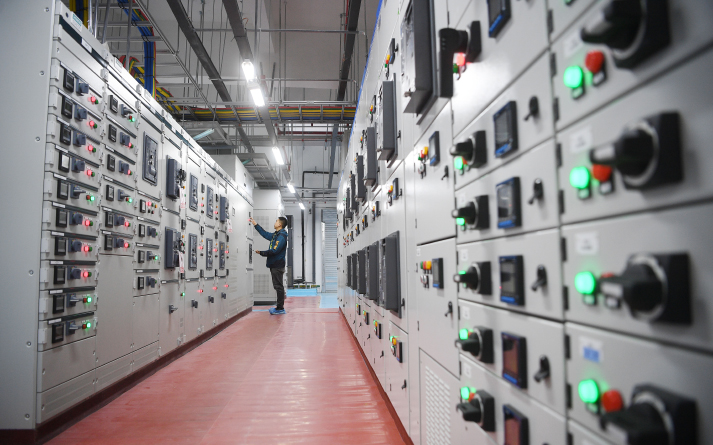
Twenty km south of Inner Mongolia Autonomous Region’s capital, Hohhot, the grassland is surging with computer power. Located out here on the open steppe is the Big Data and Cloud Computing Information Park, home to 10,000 Internet data center (IDC) racks that operate around the clock.
The center was built in 2015 by China Unicom, one of the country’s major telecom operators, and has attracted more than 100 tenants, including government departments, well-known international cloud computing providers, large Internet firms, banks and insurance companies.
“The annual mean temperature of Hohhot is 8 degrees Celsius, and natural cooling sources can be used here for about five months every year,” an executive at the center told People’s Daily, adding that through using innovative cooling methods, the company saves approximately 5 million kWh of electricity each year.
“As 5G and other new technologies develop rapidly, China’s demand for data storage and computing keeps rising, driving the rapid growth of data centers,” said He Baohong, head of the Cloud Computing and Big Data Research Institute at the China Academy of Information and Communications Technology (CAICT). According to He, in the past five years, the number of data center racks in China has grown at an average annual rate of more than 30 percent, with each supersized data center with more than 10,000 standard racks consuming at least 100 million kWh of energy every year.

East-to-west transfer
In February, the National Development and Reform Commission (NDRC), the Cyberspace Administration of China, the Ministry of Industry and Information Technology and the National Energy Administration jointly unveiled plans to build eight national computing hubs with a total of 10 data center clusters, marking the launch of the east-to-west computing resource transfer project.
The hubs will be located in the Beijing-Tianjin-Hebei region, the Yangtze River Delta, the Guangdong-Hong Kong-Macao Greater Bay Area, the Chengdu-Chongqing economic circle, Inner Mongolia, Guizhou Province, Gansu Province and Ningxia Hui Autonomous Region. They will constitute the backbone of a
computing network that integrates data centers, cloud computing and big data. The project is expected to bridge the gap between eastern and less developed western regions in computing resources.
According to the Open Data Center Committee, a Beijing-based nonprofit organization formed by enterprises and institutions related to the data center industry, data centers across China consumed 93.9 billion kWh of electricity in 2020. The figure will reach 380 billion kWh by 2030. China’s vast central and western regions have abundant clean energy supplies such as wind and solar power.
“Using resources in the western region to meet the computing demand of the eastern region will gradually address the imbalance between the supply and demand of data centers in China, which will be conducive to cultivating a hyper-scale data market,” said He, adding that the project will help lift the network capabilities of all regions and data centers, thereby improving the level of Internet connectivity across the country.
“Advancing the east-to-west transfer of computing resources is an important project to address the unbalanced development in China,” said Li Hongwu, head of China Unicom Research Institute.
According to Li, the project will not only bring investment to the western region through the construction of new computing infrastructure to facilitate local industrial restructuring and economic transformation, but also boost the coordinated development of the country’s entire digital economy.
Vast market opportunities
“The east-to-west computing resource transfer project covers a large number of areas with high data consumption, making the existing backbone networks (principal data routes) insufficient,” Wang Tiejun, deputy general manager of the material business unit of Yangtze Optical Fiber and Cable Joint Stock Co. Ltd., told People’s Daily. According to him, the project will propel the upgrading of the transmission speed of the backbone network, bringing new market opportunities for enterprises like his company.
Server producers also see a promising market. Huang Yue, an executive of Lenovo Infrastructure Solutions Group, said the project will give a strong push to the data center industry, and help maintain the prosperity of the server industry. He added that in 2022 the revenue of Chinese server producers is expected to grow by more than 10 percent.
Yu Xiaohui, head of the CAICT, said the number of data center racks in use nationwide reached 5.2 million in 2021, the IDC rack market had by then generated a total revenue of 150 billion yuan ($22.35 billion), and the market size of cloud computing had reached 303 billion yuan ($45.16 billion). The CAICT expects that, during the 14th Five-Year Plan (2021-25) period, the number of data center racks across China will grow at an annual rate of around 20 percent, and the annual revenue growth from racks and cloud computing will reach 25-30 percent and 30 percent, respectively.
The east-to-west transfer of computing resources may channel in an additional investment of as much as 400 billion yuan ($59.61 billion) every year, and the improvement of computing power-related facilities in the western region will bring opportunities to local information technology and green energy industries, said Xu Bin, deputy director of the Innovation-Driven Development Center of the NDRC.
Cross-regional management
Among the 5.2 million standard data center racks across China, only 20 percent are located in the western region, said the People’s Daily report. Nevertheless, those in east China are facing land and resource restrictions. As the east-to-west transfer of computing resources advances, will data producers and users of computing power downstream on the industry chain choose the western region as a location to store and compute the data?
“The total costs of a data center consist of spending on construction and day-to-day operations,” said Ding Hongqing, Deputy General Manager of the Planning and Construction Department of China Mobile Communications Group Co. Ltd. Of the total, electricity bills account for more than 50 percent. “In the western region, natural cooling sources can be used to save electricity, and the power prices there are also much lower than in the eastern region,” he added.
However, restricted by its inadequate network and technological capabilities, shortage of professionals and underdeveloped market environment, the western region still has a long way to go in the development of its big data industry.
Ding believes the western region should explore ways of improving user experience by introducing new management methods for cross-region data storage and processing and building an efficient and flexible system for mobilizing computing resources.
“Data storage and computing are capital intensive with a long investment recovery period. It will be unsustainable if the western region only relies on government subsidies for electricity and land use to attract data centers,” said Wu Hequan, an academician at the Chinese Academy of Engineering. He suggested that the western region should improve the industrial ecosystem and focus on expanding both the upstream and downstream of the big data industry.






